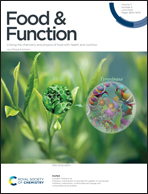Chemical characterization and in vivo antioxidant activity of parsley (Petroselinum crispum) aqueous extract
Abstract
Twenty-nine flavonoid glycosides were identified in the aqueous extract (PC) of Petroselinum crispum var. crispum leaves and apiin, the major compound, was isolated thereof. Apigenin was obtained (90% purity) by the hydrolysis of apiin. A high content of phenolics (12.49 ± 1.70 mg GAE per g of parsley extract – Folin–Ciocalteu method) and total flavonoids (15.05 ± 2.20 mg of quercetin equivalents per g of parsley extract – aluminum chloride method) was quantified in P. crispum, as well as high antioxidant activity ((EC50 – 15.50 mg mL−1, DPPH method) and (189.8 mM Fe(II) per mg of dry plant aqueous extract – FRAP method)). In vivo analysis with Saccharomyces cerevisiae cells showed low toxicity of the aqueous extract of parsley, however, it revealed a high dose-dependent antioxidant potential, mainly in the lipoperoxidation assay. In addition, flavonoid apiin also showed antioxidant action on yeast cells under oxidative stress in the cell viability assay (0.1 mM) and lipid peroxidation (0.01 and 0.1 mM), while apigenin was slightly antioxidant. Therefore, it is likely that the antioxidant activity of apiin is related to the total antioxidant capacity of parsley.

- This article is part of the themed collection: Celebrating Latin American Talent in Chemistry


 Please wait while we load your content...
Please wait while we load your content...